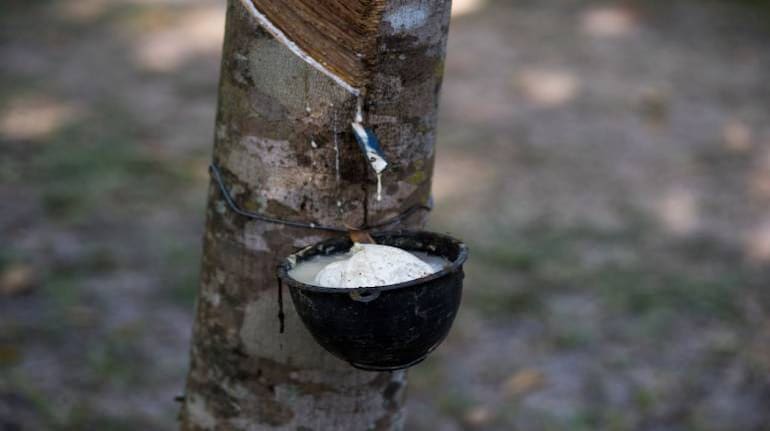



A host of global factors such as high inflation, weak Chinese demand and the European energy crisis, along with the mass arrival of imports and the onset of the peak tapping season, have led to a crash in the Indian natural rubber sheet prices.
Price of the RSS 4 variety, used chiefly by the tyre industry, has sunk to a 16-month low and is at Rs 150 per kg in the Indian market.
The plunge in the international rubber market is even more compared to that in India. While the international tyre grade sheet variety RSS 3 plummeted by 21% in over two months to around Rs 123 per kg, the slump has been to the extent of 16% for RSS 4 in the Indian market during the same period.
“The falling rubber price in India is a reflection of what is happening in the international market. Rising inflation and the possibility of a global recession have increased regulatory pressures like hikes in interest rates. This has killed demand and quenched prices,’’ said Ashish Pandey, vice president, materials, JK Tyres.
Impact of rain, flooding
The second quarter is generally a slack season for the tyre market, but heavy rains and flooding in several places have further squeezed demand in India, Pandey said.
Global demand prospects have been further dented amid new COVID-19 lockdowns in China and soaring energy prices in Europe, said rubber expert and analyst Jom Jacob.
“China introduced more lockdowns as new coronavirus cases stay at elevated levels. The continuing lockdowns in the country’s major cities and economic hubs imply that China’s economy will need a longer time to return to a normal growth track. As China represents 42% of the global demand, the developments in China are crucial for the global demand prospects of natural rubber,” analyst Jom Jacob said.
Gas prices in Europe spiralled by 30% as Russia shut the pipeline supplying gas to Germany at a time when the Russian invasion of Ukraine has already driven up the energy prices.
“The soaring energy prices in the Europe and the abnormal further jumps anticipated during the winter can have major negative implications for the NR demand outlook for the region,’’ Jacob said.
Industry turns to imports
In the domestic market, lack of sufficient quantity of rubber from growers in the last 2-3 months prompted the tyre industry, the major user of the commodity, to book imports to bridge the gap.
Incessant rains in Kerala, the biggest rubber-producing state, had crimped the supply. “The imports of mostly TSR (a rubber variety) contracted earlier are arriving now, which has affected rubber prices,’’ said Kottayam-based rubber trader Biju John.
The peak rubber tapping season in Kerala commences from this month and the arrivals are likely to increase in the next 3-4 months provided heavy rains don’t hamper production.
Rubber Board data shows there was an over 5 percent increase in production in April-July of FY23 at 197,000 tonnes from a year ago. Consumption for the period was up by 12 percent to 467,000 tonnes. Imports too have risen by 10 percent to 165,337 tonnes, provisional figures show.
Latex price drop
Although Kerala government’s price support scheme ensures Rs 170 per kg to small growers by subsidising the difference with the market price, there is general lack of enthusiasm fortapping because of a sharp fall in latex prices.
Many farmers had turned to latex production as the prices soared because of huge demand for gloves during the pandemic. “The field latex prices have dropped from around Rs 180 per kg a few weeks ago to over Rs 120 per kg now,’’ John said.
Import arrivals accelerated as Indian buyers are now bringing it directly to circumvent delays in Colombo port.
“There is a 30-40 day delay in Colombo port. So the imports are now directly coming to Chennai and Mumbai ports,’’ said Ketan Joshi, director of the Cochin Rubber Merchants Association.
New markets
Tyre makers and other rubber industry users have been exploring newer markets for imports as production in some of the regular producing countries had slackened.
Ivory Coast, Cambodia and Vietnam have been exporting more rubber this year. Rising value of the dollar against major currencies has helped push exports.
According to Jom Jacob, Ivory Coast has emerged as a major exporter of TSR, which is imported more by the Indian tyre industry. Around 90% of the imports are in the form of TSR, also called block rubber.
“Currently, Ivory Coast is India's largest supplier of TSR as it has been able to sell the produce at much competitive prices because of high average annual yield,’’ he said.
The country has become the fourth largest rubber producer after Thailand, Indonesia and Vietnam. It is expected to move up to the third position in 2023. The export of rubber from the country increased 17% year-on-year to 724,000 tonnes during January-July 2022 period, with China and India being the two major importers, Jacob said.
But the tyre industry is optimistic about third-quarter sales as the festival season commences.
“India is also better placed than many other countries on GDP growth. We expect the situation to improve well by the last quarter after annual maintenance by major automobile makers in December,’’ said Pandey of JK Tyres.
Discover the latest Business News, Sensex, and Nifty updates. Obtain Personal Finance insights, tax queries, and expert opinions on Moneycontrol or download the Moneycontrol App to stay updated!
Find the best of Al News in one place, specially curated for you every weekend.
Stay on top of the latest tech trends and biggest startup news.